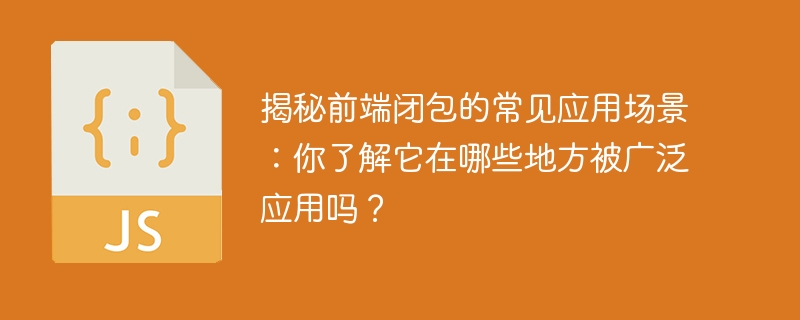

Revealing the common application scenarios of front-end closures: Do you know where it is widely used?
Closure is a very important concept in JavaScript and one of the features often used in front-end development. It can handle variable scope and protect data efficiently, while also providing a powerful mechanism to handle asynchronous operations and function encapsulation.
So, do you know what common application scenarios of closures in front-end development? Next, we will reveal some common application scenarios of closures and give specific code examples.
1. Modular development
In front-end development, we often use modular development to organize code structure and encapsulate functions. Closures can help us achieve modular development. By using closures, we can hide some private variables and methods and only expose some public interfaces for external use.
The following is a simple example showing how to use closures to implement a counter module:
var Counter = (function() {
var count = 0;
function increment() {
count++;
console.log(count);
}
function decrement() {
count--;
console.log(count);
}
return {
increment: increment,
decrement: decrement
};
})();
Counter.increment(); // 输出 1
Counter.increment(); // 输出 2
Counter.decrement(); // 输出 1In the above code, we create a closure using an immediate execution function. The package contains a private variable count and two private methods increment and decrement. In this way, the outside world cannot directly access and modify count, and can only operate through the exposed public interface increment and decrement methods.
2. Event processing
Closure can also help us save some status or data during event processing. Usually, when binding an event handling function, we cannot directly pass some additional parameters to the function. However, by using closures, we can save these parameters in the closure and retrieve and use them when the event fires.
Here is a simple example showing how to use closures to save and use additional parameters:
function createButton(text) {
var button = document.createElement('button');
button.innerHTML = text;
button.addEventListener('click', function() {
alert(text);
});
return button;
}
var button1 = createButton('Button 1');
var button2 = createButton('Button 2');
document.body.appendChild(button1);
document.body.appendChild(button2);In the above code, we define a createButton Function, this function accepts a text parameter text and returns a created button element. While creating the button, we use a closure to save the text corresponding to the button. When the button is clicked, the text saved in the closure will pop up.
3. Asynchronous operations
Closures are also very useful when dealing with asynchronous operations. By using closures, we can access and process some variables or data after the asynchronous operation is completed. This method is often used in Ajax requests, timers, event binding and other scenarios.
The following is a simple example showing how to use closures to handle an asynchronous operation:
function fetchData(url, callback) {
setTimeout(function() {
var data = 'Some data';
callback(data);
}, 1000);
}
var result;
fetchData('https://example.com/api', function(data) {
result = data;
});
setTimeout(function() {
console.log(result); // 输出 'Some data'
}, 2000);In the above code, we define a fetchData function, This function returns some data by simulating an asynchronous operation. After the asynchronous operation is completed, we use a closure to save the returned data and then access and use it again at a later time.
Closure is a very powerful and important concept in JavaScript. It has a wide range of application scenarios in front-end development. Not only can it help us achieve modular development, but it can also handle events and asynchronous operations. By using closures flexibly, we can better write maintainable and performant front-end code.
I hope the application scenarios of closures introduced in this article can be helpful to you and can be used flexibly in actual development.
The above is the detailed content of Demystifying front-end closures: What common application scenarios do you know?. For more information, please follow other related articles on the PHP Chinese website!
 Is python front-end or back-end?
Is python front-end or back-end?
 How to implement instant messaging on the front end
How to implement instant messaging on the front end
 The difference between front-end and back-end
The difference between front-end and back-end
 Introduction to the relationship between php and front-end
Introduction to the relationship between php and front-end
 How do mysql and redis ensure double-write consistency?
How do mysql and redis ensure double-write consistency?
 What should I do if English letters appear when I turn on the computer and the computer cannot be turned on?
What should I do if English letters appear when I turn on the computer and the computer cannot be turned on?
 Computer software systems include
Computer software systems include
 How to remove watermark from clipping
How to remove watermark from clipping